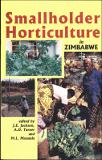| dc.identifier.citation | Nzima, M.D.S. (1997) Opportunities for increasing land and crop productivity among Zimbabwe’s small-scale irrigation schemes. In: Jackson, J.E., Turner, A.D. and Matanda, M.L. (eds.) Smallholder horticulture in Zimbabwe. Harare: UZ Publications, pp. 19-27. | en |
| dc.description.abstract | Land productivity, crop yields, and the associated production costs and cash returns of five different cropping systems were compared to the farmers’ cropping practices (FCP) from 1983 to 1986 in the southeast of Zimbabwe. In most cases, the FCP involve growing of either maize (for green mealies or for grain), cotton or groundnuts as the main cash crop during summer followed in winter by vegetables (tomato, onion, cabbage, and other leafy brassicas), wheat and/or beans. Generally, during each cropping season, a single crop occupied the whole plot owned by an individual farmer resulting in the growing of two or three crops within a year.
Land was split to accommodate at least three crops during each growing season for a total of 9 to 12 crops per year under the five different cropping systems that were tested. The crops that were grown included maize (for green mealies), tomato, cabbage, cauliflower, rape (Brassica napus), sweet potato, okra, onion, garlic, beans and watermelon. These multicrop systems produced significantly higher profits (P<0.01) than the FCP but needed timely and more disciplined management. The FCP were slightly less expensive than multicrop systems because of the comparatively smaller quantities of seed and fertilizer used. Land productivity and crop yields under the FCP were low because of long intervals between successive crops, unreliable irrigation water and the inflexibility of the Agricultural, Technical and Extension Services (AGRITEX) advice on the choice of crops to be grown by a farmer during a cropping season. Labour accounted for 42 to 52% of the production costs among all the cropping systems tested. Fertilizer, seed and crop protection chemicals accounted for 19, 18 and 9 percent respectively. Profitability indices for crops that can be grown all year round are provided, however, the final choice of when and which crop combinations to be grown at any particular time should be the responsibility of the farmer. | en |


